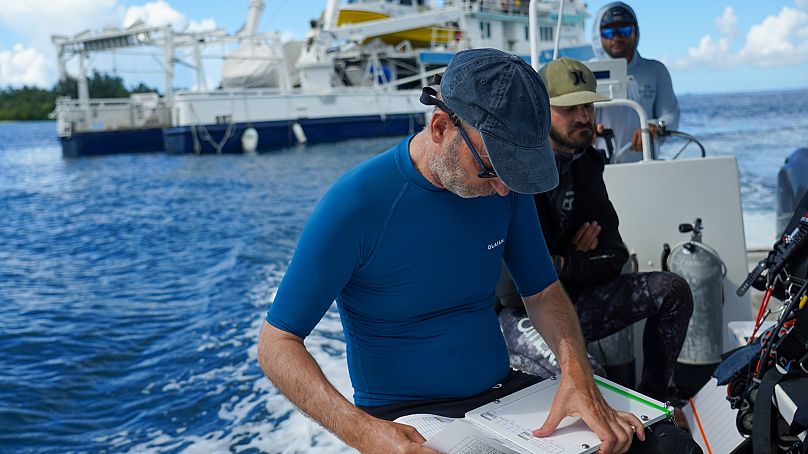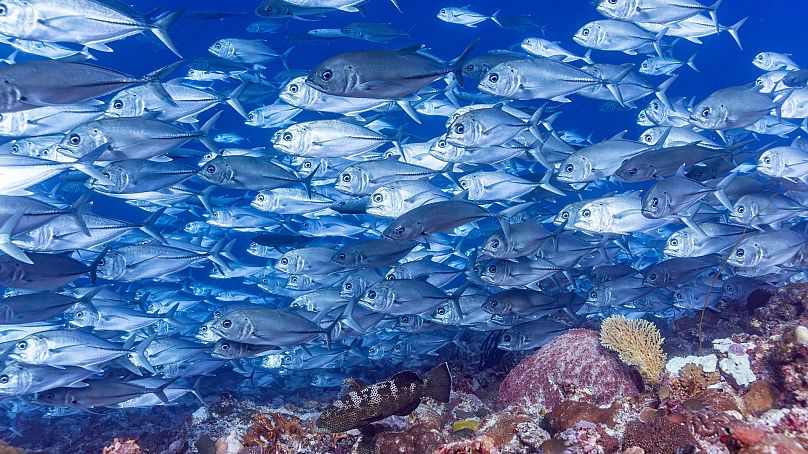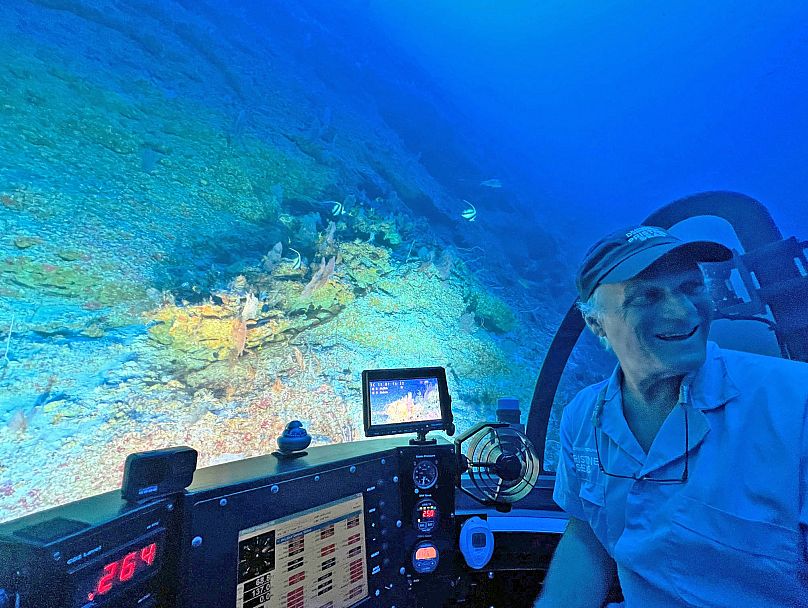
From Euronews by Rosie Frost
Hours of scuba diving and sending cameras thousands of metres down will help the government to preserve biodiversity.
Cutting edge tech and local knowledge are helping a group of scientists in Papua New Guinea survey the country’s highly biodiverse ocean ecosystems.
They are hoping it will provide the government with data to improve conservation efforts.
Papua New Guinea lies in the coral triangle, one of the most biologically diverse places in our oceans.
It is home to more than 2,000 species of fish - some of which are found nowhere else on Earth.
600 hard coral species can be found here with the greatest concentration of clownfish diversity anywhere in the world.
The three-month scientific expedition is a partnership between National Geographic Pristine Seas, the government of Papua New Guinea’s Conservation and Environment Protection Authority (CEPA), and the Wildlife Conservation Society (WCS).
“The Coral Triangle is a global marine biodiversity hotspot. It has more species of fish, corals, and anything else in the world. It's the rainforest of the ocean,” explains Dr Alan Friedlander, lead scientist for the National Geographic Pristine Seas’ expedition.
Living and working aboard the Argo research vessel, a typical day could see the team counting seabirds, setting up cameras which can go to incredible depths of 6,000 metres or diving to observe the wildlife living around reefs.
Long dives mean they are in the water pretty much all day.
“We actually did some of the deepest deployments of cameras anywhere and found a bunch of really interesting new species for Papua New Guinea, a lot of deep water sharks,” Friedlander says.
Hours of scuba diving and sending cameras thousands of metres down will help the government to preserve biodiversity.
Cutting edge tech and local knowledge are helping a group of scientists in Papua New Guinea survey the country’s highly biodiverse ocean ecosystems.
They are hoping it will provide the government with data to improve conservation efforts.
Papua New Guinea lies in the coral triangle, one of the most biologically diverse places in our oceans.
It is home to more than 2,000 species of fish - some of which are found nowhere else on Earth.
600 hard coral species can be found here with the greatest concentration of clownfish diversity anywhere in the world.
The three-month scientific expedition is a partnership between National Geographic Pristine Seas, the government of Papua New Guinea’s Conservation and Environment Protection Authority (CEPA), and the Wildlife Conservation Society (WCS).
“The Coral Triangle is a global marine biodiversity hotspot. It has more species of fish, corals, and anything else in the world. It's the rainforest of the ocean,” explains Dr Alan Friedlander, lead scientist for the National Geographic Pristine Seas’ expedition.
Living and working aboard the Argo research vessel, a typical day could see the team counting seabirds, setting up cameras which can go to incredible depths of 6,000 metres or diving to observe the wildlife living around reefs.
Long dives mean they are in the water pretty much all day.
“We actually did some of the deepest deployments of cameras anywhere and found a bunch of really interesting new species for Papua New Guinea, a lot of deep water sharks,” Friedlander says.
 Quim preparing documents before coral reef survey near Tunnung Island, New Ireland Province, Papua New Guinea.
Quim preparing documents before coral reef survey near Tunnung Island, New Ireland Province, Papua New Guinea.“What we typically do on an expedition is we throw everything at it because oftentimes we have the advantage of having the vessel.
Not much work has been done in these places, in many of the areas we have gone.
So we try to do as comprehensive a job as possible.”
Overfishing, warming oceans and pollution all threaten Papua New Guinea’s biodiversity
Jelta Wong, Papua New Guinea’s Minister for Fisheries and Marine Resources says the threat’s its oceans face are “varied and interlinked - from illegal unreported and unregulated fishing to global warming.”
Like many other locations around the world, corals here have suffered over recent months from extremely high marine temperatures.
A diverse population of fish which act like “lawnmowers” on the reef can help them to bounce back after bleaching events but that relies on protecting the biodiversity that exists there.
Some large-scale fishing practices, known as illegal, unregulated and unreported fishing, threaten these populations of fish.
With a lot of abandoned ordinances from World War II, extremely damaging methods like dynamite fishing are still used in Papua New Guinea.
This is extremely dangerous for the fisherman and destructive, obliterating the habitat meaning the fish never return.
 Healthy coral reefs in New Ireland Province, Papua New Guinea.
Healthy coral reefs in New Ireland Province, Papua New Guinea.“Because a lot of places now depend on central markets, the monetisation of these resources, oftentimes people don't fish as sustainably as they once did,” Friedlander explains.
Not all fishing is bad, however, providing an income and a vital food source for the people that live there, but Friedlander explains that it needs to be managed better than it currently is.
Poor land use practices too are a threat - runoff from both local and large-scale agricultural activity like palm oil plantations disrupts the ecosystem.
Sewage from cesspools also makes its way to the oceans, contributing to the problem.
And plastic pollution damages the reef adding to the pressures it already faces.
Combining local knowledge with cutting edge research methods
The National Geographic Pristine Seas team never goes to a place unannounced, engaging with local communities about the research they are carrying out before, during and after their expedition.
Not all fishing is bad, however, providing an income and a vital food source for the people that live there, but Friedlander explains that it needs to be managed better than it currently is.
Poor land use practices too are a threat - runoff from both local and large-scale agricultural activity like palm oil plantations disrupts the ecosystem.
Sewage from cesspools also makes its way to the oceans, contributing to the problem.
And plastic pollution damages the reef adding to the pressures it already faces.
Combining local knowledge with cutting edge research methods
The National Geographic Pristine Seas team never goes to a place unannounced, engaging with local communities about the research they are carrying out before, during and after their expedition.
“We've also had community members out on the boats with us every day, which is great because they tell us about the spots they're most concerned about,” Friedlander says.
These voices need to be heard because they are the ones most likely to be affected by the poor quality or poor health of their marine resources and they know the area best.
Freidlander adds that many of the local people engaged in the project ask what they can personally do about climate change.
These voices need to be heard because they are the ones most likely to be affected by the poor quality or poor health of their marine resources and they know the area best.
Freidlander adds that many of the local people engaged in the project ask what they can personally do about climate change.

A school of hundreds of jacks in New Ireland Province, Papua New Guinea.
“What I tell them is it's a global problem that Papua New Guinea did not create.
And the countries that have created it, the onus is on them and the national governments to mitigate that.”
But, he says, while many solutions are out of their control, what they can do is the same as everyone else on the planet - take care of their own backyard to slow the effects.
“A lot of the management strategies that we have today were developed thousands of years ago by the islanders.”
Friedlander highlights the Indigenous marine protected areas (MPAs) that exist across the Pacific Ocean.
These are historically almost spiritual places but entangled with that is their place in preserving marine life.
He recounts visiting one such area off the coast of Maschu Island in the north of the country and learning about its vital role in the lifecycle of the grouper.
“Groupers only get together around either the new moon or the full moon for only a couple of months out of the year,” he says.
“Then these groupers, they come from kilometres away to this one spot and normally they're kind of solitary animals.”
Because they are in a predictable place at a predictable time and distracted by reproduction, their populations have been decimated by overfishing.
They can live for up to 60 years and their populations take a long time to regenerate once they are removed from the reef.
Local people have been protecting this spot where they spawn for decades, understanding that allowing them to breed undisturbed will ensure the survival of the species.
How does ocean research help with conservation?
In this vastly understudied region, detailed scientific data is needed for the country to effectively manage its marine resources.
In November 2023, Papua New Guinea tripled its ocean protections by announcing nearly 17,000 km² of provincially-protected MPAs in its Lovongai and Murat jurisdictions.
These came about through the will of local people and the Wildlife Conservation Society.
More than 9,000 people from over 100 Indigenous communities were involved in the consultation.
There were some of the first MPAs in the world with measures designed to protect the most threatened sharks and rays.
“The provincial government, with the Wildlife Conservation Society, has been creating some, proposals for large marine protected areas,” Friedlander says.
“Nested within that are the local community protected areas.
There were a lot of community consultations over the years to create these two large protected areas, but there wasn't a lot of biological information.”
 National Geographic Pristine Seas senior marine researcher Alan Friedlander aboard the DeepSee submersible in Rongerik Atoll in t he Marshall Islands.
National Geographic Pristine Seas senior marine researcher Alan Friedlander aboard the DeepSee submersible in Rongerik Atoll in t he Marshall Islands. These places are difficult for researchers to get to and, despite incredible local environmental knowledge, there isn’t much scientific work for the government to use when pitching conservation efforts.
“What we are bringing to the table is this comprehensive data set of everything from seabirds and the shallow water down to the deepest depths,” Friedlander says.
“So our data hopefully helps provide some of the information so that the local governments can make wise choices when they create their protected areas, so they're most effective and beneficial to the communities.”
Filmmakers are also working on land to learn about communities’ personal connections to the sea and help memorialise traditional ocean protection practices.
The Pristine Seas team returns to the location of their expedition after all the data has been worked up to share this film and their findings.
“We'll come back to these communities and we'll show the film. We'll highlight to them our findings. We'll show the scientific report,” Friedlander concludes.
“What that does is that helps fill in the biological gaps. And then it's up to the national government to hopefully recognise these provincial protected areas.”
Links :
- National Geographic : Papua New Guinea: Pristine Seas Explores one of the Most Biodiverse Oceans on Earth
No comments:
Post a Comment